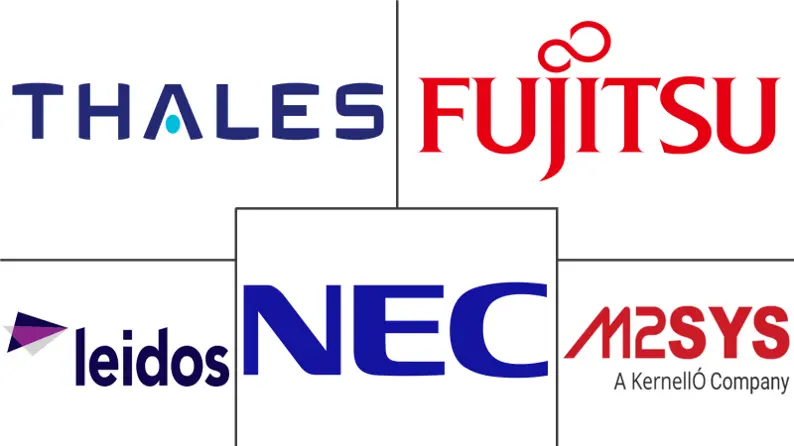Biometrics-as-a-Service Market Size and Share
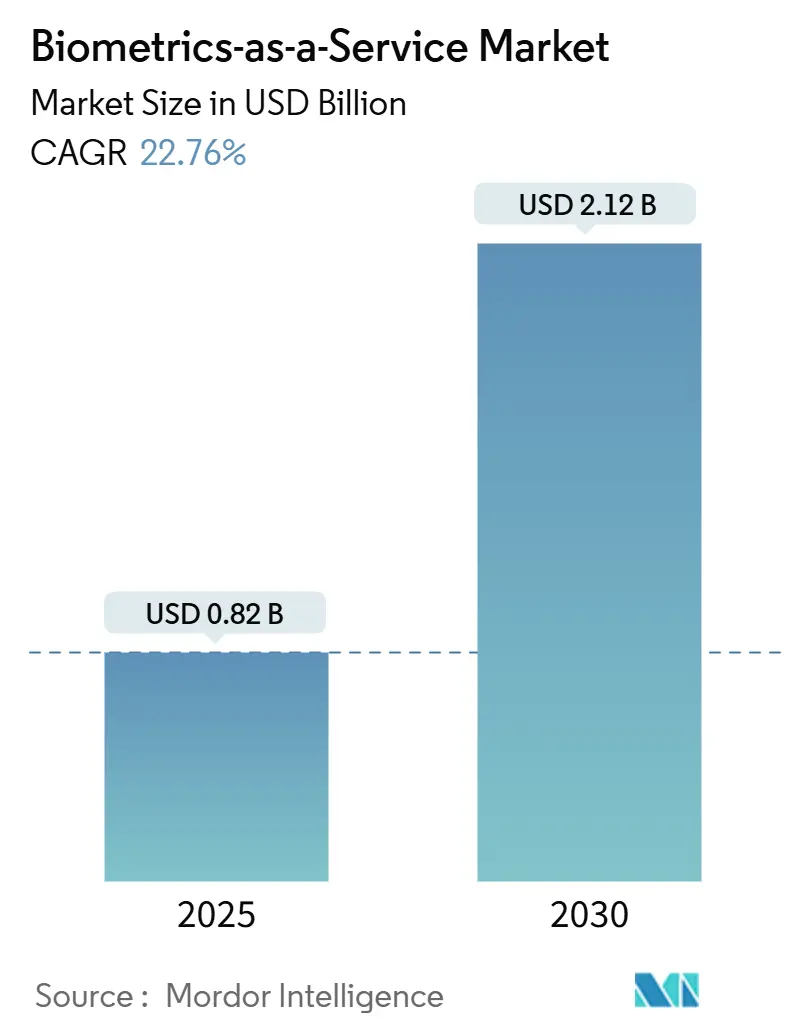
Biometrics-as-a-Service Market Analysis by Mordor Intelligence
The Biometrics-as-a-Service market size stood at USD 0.82 billion in 2025 and is forecast to reach USD 2.12 billion by 2030, reflecting a 22.76% CAGR over the period. Momentum stems from enterprises shifting identity verification workloads to the cloud to trim on-premises infrastructure costs and to counter sophisticated fraud attempts.[1]Microsoft Corporation, “Microsoft Entra ID—Identity and Access Management,” microsoft.com Public-sector digital-ID programs across emerging economies, rising smartphone-native biometric adoption, and WebAuthn password-less rollouts further reinforce demand. Multimodal authentication advances, hyperscalers’ compliance certifications, and post-quantum encryption alignment are expanding commercial use cases. Meanwhile, regulatory pressure to detect deepfakes and mitigate bias is shaping solution roadmaps and regional deployment choices.
Key Report Takeaways
- By application, mobile authentication led with 28.62% revenue share in 2024 in the Biometrics-as-a-Service market; border and immigration control is projected to expand at a 23.12% CAGR through 2030.
- By biometric modality, fingerprint recognition held 31.63% Biometrics-as-a-Service market share in 2024, while multimodal solutions are growing at a 23.22% CAGR to 2030.
- By deployment model, public cloud accounted for 57.93% share of the Biometrics-as-a-Service market size in 2024 and hybrid cloud is advancing at a 23.89% CAGR through 2030.
- By end-user, government and public sector commanded 28.93% share of the Biometrics-as-a-Service market size in 2024, whereas BFSI is forecast to grow at a 23.45% CAGR to 2030.
- By geography, North America held 38.73% revenue share in 2024 in the Biometrics-as-a-Service market; Asia-Pacific is poised for a 23.45% CAGR between 2025 and 2030
Global Biometrics-as-a-Service Market Trends and Insights
Drivers Impact Analysis
| Driver | (~) % Impact on CAGR Forecast | Geographic Relevance | Impact Timeline |
|---|---|---|---|
| Rising volume and value of online transactions | +4.2% | Global, with concentration in APAC and North America | Medium term (2-4 years) |
| Explosion of deep-fake mitigation mandates | +3.8% | Global, led by EU and North America regulatory frameworks | Short term (≤ 2 years) |
| Cloud-native IAM suites embedding biometrics | +5.1% | North America and Europe, expanding to APAC | Medium term (2-4 years) |
| Post-quantum cryptography complementarity | +2.9% | Global, with early adoption in government and BFSI | Long term (≥ 4 years) |
| National digital-ID roll-outs (G2P and G2C) | +4.7% | APAC core, expanding to South America and Africa | Medium term (2-4 years) |
| WebAuthn-based password-less workspaces | +3.6% | North America and Europe enterprise markets | Short term (≤ 2 years) |
| Source: Mordor Intelligence | |||
Rising Volume and Value of Online Transactions
Digital payment volumes hit 1.86 trillion transactions in 2024, overwhelming password systems and elevating demand for cloud-scale biometric verification. Banks moving from on-premises biometrics to SaaS models report 67% lower authentication latency, enabling real-time fraud analytics. The Biometrics-as-a-Service market answers these scalability needs by auto-provisioning compute during transaction spikes. Lower latency also improves user experience, which lifts conversion rates for high-frequency mobile payments. As cross-border e-commerce expands, merchants prefer unified APIs that streamline KYC across jurisdictions, reinforcing market uptake.
Explosion of Deep-fake Mitigation Mandates
The EU AI Act compels financial institutions to deploy technical defenses against synthetic media by December 2025.[2]European Commission, “European Approach to Artificial Intelligence,” europa.eu Deepfake tools can create convincing facial videos from single images, challenging single-factor checks. Biometrics-as-a-Service market providers now bundle liveness detection that tracks micro-expressions, pupillary response, and voice harmonics harder to spoof. Continuous authentication during video calls or remote onboarding deters synthetic identity fraud. Compliance deadlines accelerate procurement cycles, while insurers increasingly require deepfake safeguards in cyber-risk policies, further stimulating adoption.
Cloud-native IAM Suites Embedding Biometrics
Microsoft Entra ID alone handled over 30 billion authentications per month in 2024, with biometrics constituting 43% of logins. IAM vendors embed biometric APIs into single sign-on flows, removing the need for separate infrastructure and trimming total cost of ownership. The integrated approach aligns user provisioning, MFA orchestration, and audit trails, giving CISOs centralized visibility. As more SaaS apps federate through SAML- or OIDC-based IdPs, the embedded biometric channel becomes the default. This convergence is expanding the Biometrics-as-a-Service market beyond traditional security budgets into broader digital-workplace initiatives.
Post-quantum Cryptography Complementarity
NIST finalized quantum-resistant algorithms in August 2024.[3]National Institute of Standards and Technology, “First Post-Quantum Encryption Standards,” nist.gov Enterprises pairing these protocols with biometric verification create layers that remain secure when quantum decryption becomes viable. Early trials in defense and capital-markets show hybrid models where a biometric check unlocks a quantum-safe private key, preserving zero-trust posture. Vendors are redesigning SDKs to sign biometric templates with lattice-based signatures, bolstering chain-of-custody. These innovations future-proof deployments and add a strategic dimension that differentiates full-service providers in the Biometrics-as-a-Service market.
Restraints Impact Analysis
| Restraint | (~) % Impact on CAGR Forecast | Geographic Relevance | Impact Timeline |
|---|---|---|---|
| Third-party cloud data-sovereignty concerns | -2.8% | Europe and APAC, driven by GDPR and local regulations | Medium term (2-4 years) |
| Bias and demographic performance gaps | -1.9% | Global, with heightened scrutiny in North America and EU | Long term (≥ 4 years) |
| Fragmented certification and liability regimes | -2.1% | Global, with varying standards across jurisdictions | Medium term (2-4 years) |
| Synthetic identity fraud arms-race | -1.6% | Global, concentrated in digital-first economies | Short term (≤ 2 years) |
| Source: Mordor Intelligence | |||
Third-party Cloud Data-sovereignty Concerns
The European Data Protection Board requires sensitive biometrics to stay within approved jurisdictions, complicating multi-region SaaS rollouts. Organizations often resort to regional clouds or edge appliances, inflating deployment complexity. Some governments ban outbound template transfers entirely, restricting federated identity projects. Vendors respond by offering country-specific shards and customer-managed encryption keys, but such controls raise cost, trimming Biometrics-as-a-Service market growth where sovereignty rules are strict.
Bias and Demographic Performance Gaps
Studies show facial recognition error rates vary up to 34% across demographic groups. Litigation risk plus upcoming algorithm-accountability laws in the U.S. and EU deter adoption in consumer-facing scenarios. Vendors invest in diverse datasets and bias dashboards, yet flawless parity remains elusive. Clients in regulated sectors may postpone rollouts until models improve, tempering Biometrics-as-a-Service market expansion in sensitive applications.
Segment Analysis
By Application: Mobile Authentication Extends Lead Amid Border Control Surge
Mobile authentication accounted for 28.62% of the Biometrics-as-a-Service market in 2024 as smartphone sensors and WebAuthn turn devices into security tokens. Enterprises cite shorter login times and 73% fewer password resets after embedding device-native biometrics in MDM workflows. Consumers likewise accept fingerprint or facial unlock for fintech and e-commerce, translating into high daily transaction volumes. The Biometrics-as-a-Service market benefits because service providers manage sensor heterogeneity, firmware updates, and liveness checks through a single cloud endpoint.
Border and immigration control is the fastest-rising subsegment, set for a 23.12% CAGR through 2030 as governments automate entry/exit systems. Cloud orchestration simplifies scalability for airports handling seasonal passenger peaks, while edge caching keeps processing within sovereign zones. Vendors now bundle multimodal capture kiosks with SaaS back-ends, reducing procurement cycles. The interplay of security mandates and traveler experience goals ensures sustained spending, with growth particularly strong in Asia-Pacific smart-airport projects.
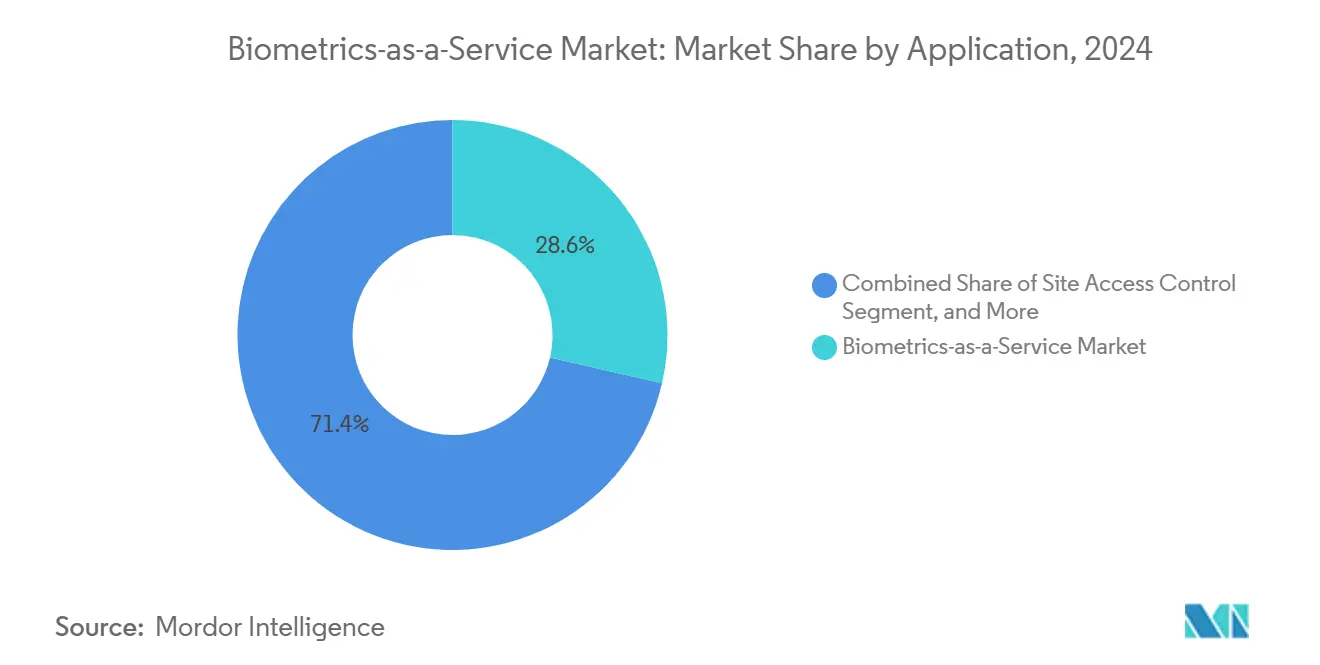
Note: Segment shares of all individual segments available upon report purchase
By Biometric Modality: Multimodal Solutions Gain Traction for Anti-spoofing
Fingerprint technology held a 31.63% Biometrics-as-a-Service market share in 2024 thanks to mature sensors, ISO template standards, and entrenched user familiarity. Large installed bases in mobile devices and ATMs keep capture costs low, ensuring ongoing volume. Yet synthetic fingerprints and silicone molds raise spoofing risk. Providers therefore pair fingerprints with passive facial or voice checks, increasing assurance without noticeable friction.
Multimodal systems will expand at a 23.22% CAGR as enterprises seek defense-in-depth against deepfakes.[4]NEC Corporation, “Launch of Multimodal Biometric Platform,” nec.com SaaS platforms unify risk scoring across face, voice, and behavioral signals, enabling adaptive MFA. Machine-learning ensembles weigh modalities based on context, improving throughput for low-risk events and stepping up scrutiny where anomalies surface. This balance of security and UX is propelling multimodal adoption across BFSI, healthcare, and remote-work use cases, further enlarging the Biometrics-as-a-Service market.
By Deployment Model: Hybrid Cloud Blends Sovereignty with Elasticity
Public clouds captured 57.93% of the market in 2024, reflecting hyperscalers’ ISO 27001 certifications, hardware HSMs, and privacy tooling. Enterprises leverage serverless architectures that ingest biometric payloads, run ML inferences, and return verdicts within 300 milliseconds. Pricing aligns to volume, lowering barriers for mid-tier customers entering the Biometrics-as-a-Service market.
Hybrid models are surging at a 23.89% CAGR as data-protection rules tighten. Organizations store templates on-premises or in private clouds while calling public endpoints for inference during peak loads. Containerized inference engines allow “bring-your-own-compute” on edge clusters in regulated zones. This duality preserves data control and auditability yet scales elastically, making hybrid the preferred blueprint for new government tenders and multinational rollouts.
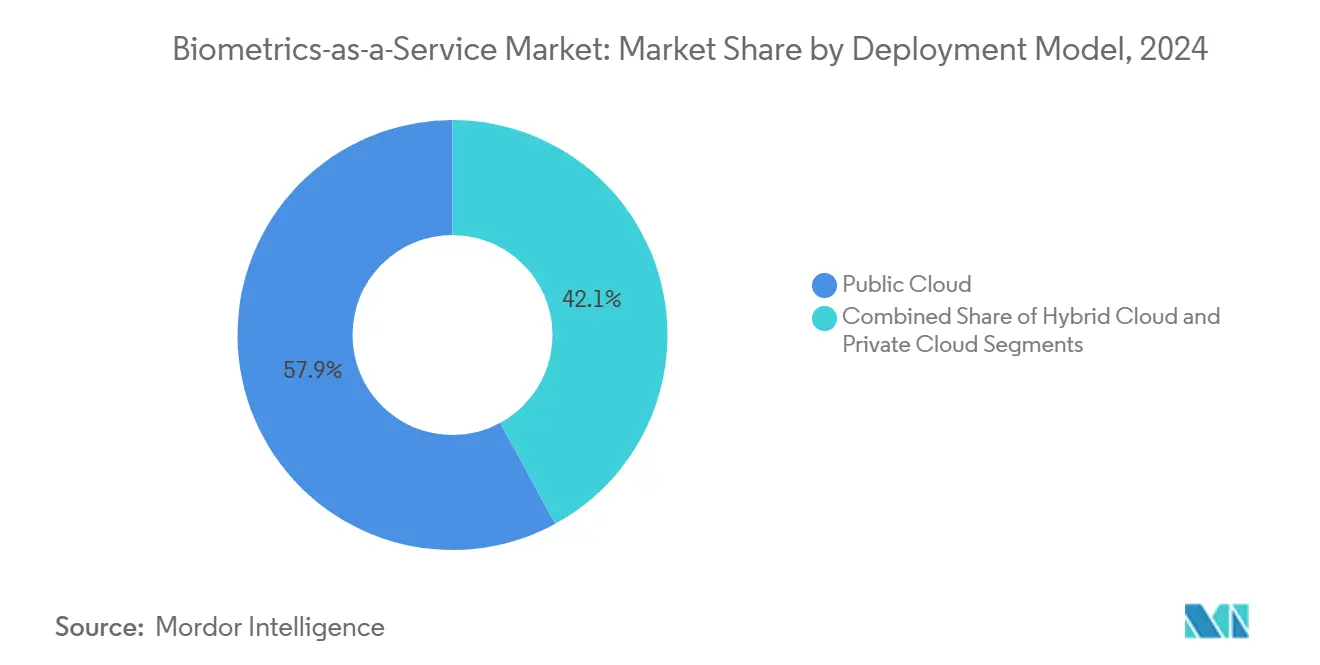
Note: Segment shares of all individual segments available upon report purchase
By End-user Industry: Government Validation Spurs Commercial Uptake
Government and public agencies claimed 28.93% of 2024 spending, driven by national-ID, border security, and welfare disbursement programs. State validation builds population-level familiarity, lowering resistance when banks and telcos deploy similar flows. Multi-agency frameworks further reduce duplication by sharing biometric back-ends across departments, reinforcing vendor lock-in and recurring SaaS revenue.
BFSI spend is climbing at 23.45% CAGR as regulators enforce strong customer authentication. Banks integrate biometrics with risk-based transaction analysis, throttling challenges for trusted sessions and escalating for high-value transfers. Insurers deploy voice-print IVRs to cut call-center fraud and improve average handle time. Healthcare, retail, and travel verticals follow suit, seeking patient ID accuracy, card-not-present fraud reduction, and frictionless guest experiences, respectively, enlarging the Biometrics-as-a-Service industry footprint.
Geography Analysis
North America dominated the Biometrics-as-a-Service market with a 38.73% share in 2024, underpinned by cloud maturity, venture funding, and clear biometric privacy statutes. Federal programs such as the U.S. biometric entry-exit system handle over 400 million annual verifications, stress-testing SaaS scalability. Canadian interoperability pilots link provincial services to a national wallet, while Mexican financial inclusion drives biometric onboarding of the previously unbanked. Together these dynamics ensure robust contract renewals and upsells.
Asia-Pacific is the fastest-advancing region, forecast at a 23.45% CAGR to 2030. National digital-ID schemes from India’s Aadhaar extensions to Singapore’s Singpass normalize biometric logins, stimulating cross-sector adoption. Japan’s My Number card expansion into healthcare and social security increases daily verification volume, while China’s mobile-payment ecosystem fuels behavioral biometrics innovation. ASEAN’s effort to harmonize trust-frameworks could unlock cross-border verification, enlarging the addressable Biometrics-as-a-Service market.
Europe shows steady but regulation-heavy growth. GDPR and the forthcoming AI Act impose algorithmic transparency, favoring providers with bias-mitigation credentials. Automotive OEMs employ in-cabin facial and iris recognition for personalization. Industrial firms deploy palm-vein stations for shop-floor access, citing hygiene and gloves compatibility. Meanwhile, the Middle East and Africa see early-stage pilots in digital banking and border management. Data-residency clauses often necessitate local hosting partners, shaping go-to-market strategies.
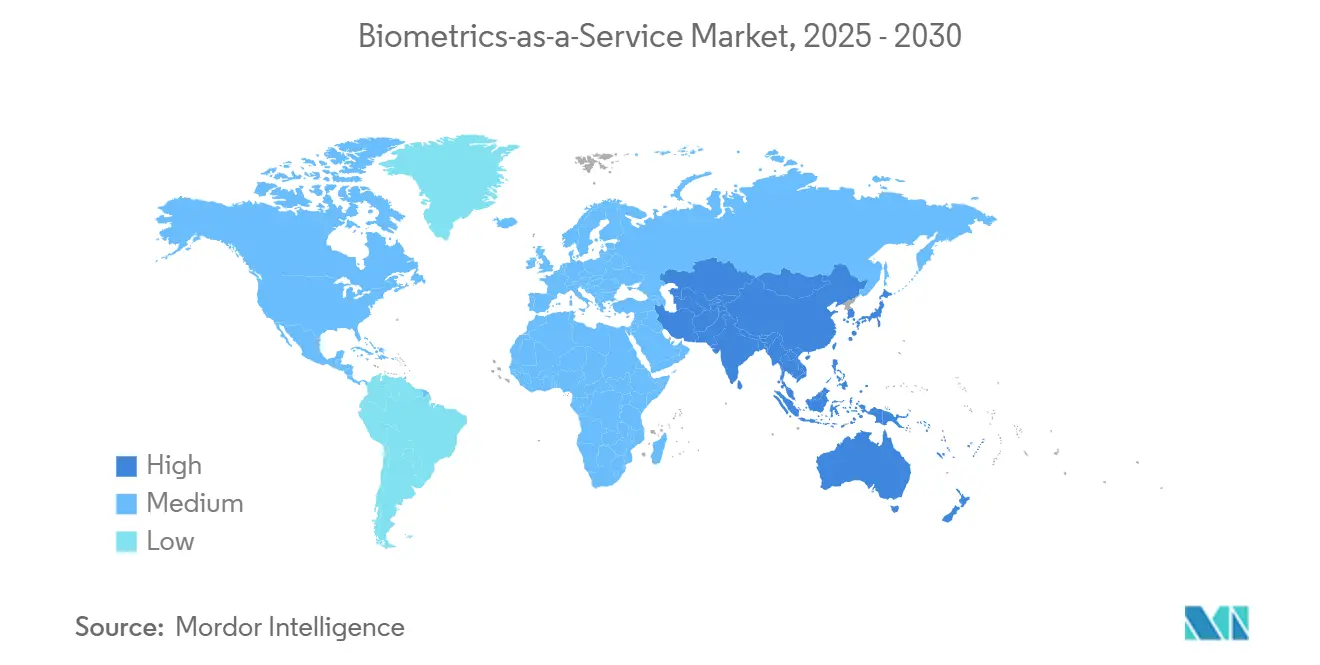
Competitive Landscape
The Biometrics-as-a-Service market is moderately concentrated, with identity giants, device OEMs, and cloud hyperscalers converging. Microsoft, Amazon, and Google embed biometric APIs into IAM suites, leveraging subscription footprints for rapid adoption. Specialized vendors such as NEC and IDEMIA deepen multimodal R&D and pursue government tenders where accuracy and sovereignty outweigh price.
M&A remains active: Thales’ 2025 acquisition of a liveness-detection start-up for USD 340 million augments anti-spoofing depth. NEC’s multimodal SaaS launch targets hybrid-work authentication, while Fujitsu markets palm-vein services to healthcare providers seeking contactless patient-ID. Edge inference and client-side template encryption differentiate emerging players attacking data-sovereignty pain points.
Partnerships flourish around standards. Ping Identity secured SOC 2 Type II for its biometric cloud, courting regulated enterprises. Daon’s FIDO Alliance certification signals password-less alignment. Suprema’s mobile SDK accelerates developer integration, reinforcing network effects. Competitive intensity revolves around template-less architectures, API richness, and global customer-support footprints, factors that will shape vendor rankings through 2030.
Biometrics-as-a-Service Industry Leaders
-
M2SYS Technology - KernellÓ Inc.
-
Fujitsu Limited
-
NEC Corporation
-
Thales Group (Gemalto NV)
-
Leidos Holdings Inc.
- *Disclaimer: Major Players sorted in no particular order
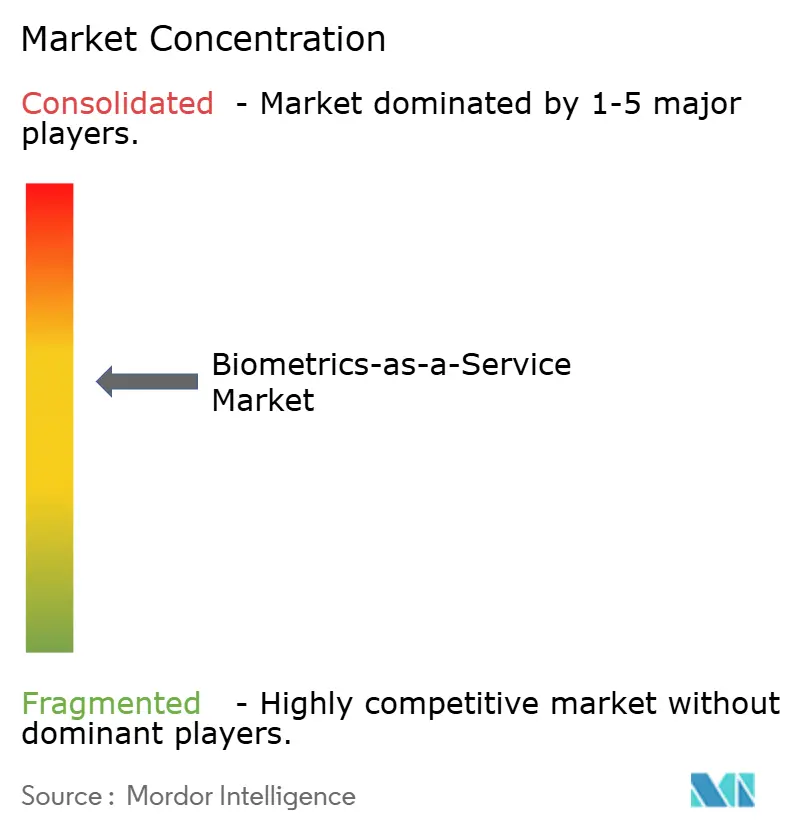
Recent Industry Developments
- March 2025: Microsoft Corporation enhanced Entra ID with behavioral biometrics for continuous authentication.
- February 2025: Thales Group acquired a biometric liveness-detection specialist for USD 340 million.
- January 2025: NEC Corporation unveiled a multimodal cloud platform combining face, voice, and behavior analytics.
- December 2024: Amazon Web Services released biometric authentication APIs for third-party developers.
Global Biometrics-as-a-Service Market Report Scope
Biometrics-as-a-service is a software that is owned and managed remotely by various providers. Biometrics technology is used to identify and authenticate people with the help of their biological and behavioral characteristics. However, biometrics-as-a-Service uses the established benefits of software-as-a-service. The study covers the popular existing biometric-as-a-Service application, scanner type, end-user industry, and geographical analysis throughout the forecast period.
| Site Access Control |
| Time and Attendance Recording |
| Mobile Authentication |
| Web and Workplace Login |
| e-Payments and Transaction Authentication |
| Border and Immigration Control |
| Law-Enforcement and Surveillance |
| Other Applications |
| Fingerprint Recognition |
| Multi-fingerprint Fusion |
| Facial Recognition |
| Iris Recognition |
| Palm and Vein Recognition |
| Voice Recognition |
| Behavioural Biometrics |
| Multimodal Biometrics |
| Other Modalities |
| Public Cloud |
| Private Cloud |
| Hybrid Cloud |
| Government and Public Sector |
| BFSI |
| Healthcare |
| Retail and E-commerce |
| IT and Telecom |
| Travel and Hospitality |
| Education |
| Other End-user Industries |
| North America | United States | |
| Canada | ||
| Mexico | ||
| South America | Brazil | |
| Argentina | ||
| Rest of South America | ||
| Europe | United Kingdom | |
| Germany | ||
| France | ||
| Italy | ||
| Spain | ||
| Netherlands | ||
| Rest of Europe | ||
| Asia-Pacific | China | |
| Japan | ||
| South Korea | ||
| India | ||
| ASEAN | ||
| Rest of Asia-Pacific | ||
| Middle East and Africa | Middle East | Saudi Arabia |
| United Arab Emirates | ||
| Turkey | ||
| Rest of Middle East | ||
| Africa | South Africa | |
| Nigeria | ||
| Kenya | ||
| Rest of Africa | ||
| By Application | Site Access Control | ||
| Time and Attendance Recording | |||
| Mobile Authentication | |||
| Web and Workplace Login | |||
| e-Payments and Transaction Authentication | |||
| Border and Immigration Control | |||
| Law-Enforcement and Surveillance | |||
| Other Applications | |||
| By Biometric Modality | Fingerprint Recognition | ||
| Multi-fingerprint Fusion | |||
| Facial Recognition | |||
| Iris Recognition | |||
| Palm and Vein Recognition | |||
| Voice Recognition | |||
| Behavioural Biometrics | |||
| Multimodal Biometrics | |||
| Other Modalities | |||
| By Deployment Model | Public Cloud | ||
| Private Cloud | |||
| Hybrid Cloud | |||
| By End-user Industry | Government and Public Sector | ||
| BFSI | |||
| Healthcare | |||
| Retail and E-commerce | |||
| IT and Telecom | |||
| Travel and Hospitality | |||
| Education | |||
| Other End-user Industries | |||
| By Geography | North America | United States | |
| Canada | |||
| Mexico | |||
| South America | Brazil | ||
| Argentina | |||
| Rest of South America | |||
| Europe | United Kingdom | ||
| Germany | |||
| France | |||
| Italy | |||
| Spain | |||
| Netherlands | |||
| Rest of Europe | |||
| Asia-Pacific | China | ||
| Japan | |||
| South Korea | |||
| India | |||
| ASEAN | |||
| Rest of Asia-Pacific | |||
| Middle East and Africa | Middle East | Saudi Arabia | |
| United Arab Emirates | |||
| Turkey | |||
| Rest of Middle East | |||
| Africa | South Africa | ||
| Nigeria | |||
| Kenya | |||
| Rest of Africa | |||
Key Questions Answered in the Report
What is the projected value of the Biometrics-as-a-Service market in 2030?
The Biometrics-as-a-Service market is expected to reach USD 2.12 billion by 2030.
Which application currently leads spending?
Mobile authentication leads spending, holding 28.62% share in 2024.
Why are hybrid deployments gaining popularity?
Hybrid models balance data sovereignty with cloud scalability, growing at a 23.89% CAGR.
Which region will grow fastest through 2030?
Asia-Pacific is forecast to register the quickest expansion at a 23.45% CAGR.
How are deepfakes influencing adoption?
Regulatory mandates to detect synthetic media are pushing enterprises toward multimodal biometrics with liveness detection.
Page last updated on:
